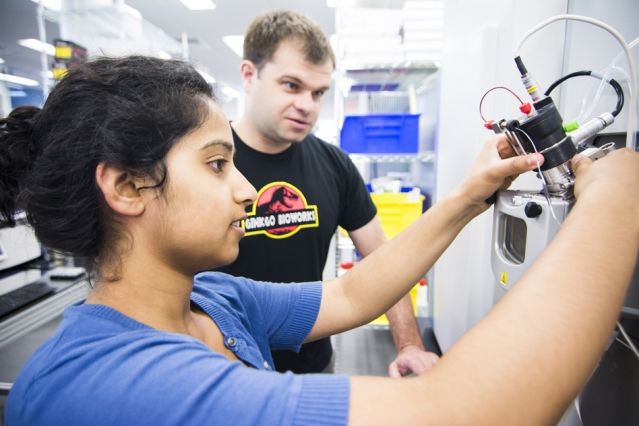Page 10925
Aug 25, 2016
Russia to Field Hypersonic Missiles by 2020
Posted by Karen Hurst in category: military
Russia is working to deploy a revolutionary hypersonic maneuvering strike missile by 2020, according to a Russian defense industry leader.
Boris Obnosov, director of the state-run Tactical Missiles Corp., told a Russian news agency the new hypersonic missile will be capable of penetrating advanced missile defenses and represents a revolutionary advance in military technology.
“It’s obvious that with such speeds—when missiles will be capable of flying through the atmosphere at speeds of seven to 12 times the speed of sound, all [air] defense systems will be weakened considerably,” Obnosov told the Rambler News Service this week.
Continue reading “Russia to Field Hypersonic Missiles by 2020” »
Aug 25, 2016
Russia More Prey Than Predator to Cyber Firm Wary of China
Posted by Karen Hurst in categories: military, security
No surprises here.
(Bloomberg) — While the West sees Russia as a cyber predator, hackers in the East increasingly view it as prey, according to online security company Kaspersky Lab, which says there?s been a sharp spike in attacks from China.
Aug 25, 2016
Financial Networking Company Prepares for?Post-Quantum World
Posted by Karen Hurst in categories: cybercrime/malcode, encryption, finance, privacy, quantum physics
Interesting read on IPC Systems Inc. is partnering with U.K. startup Post-Quantum to (in their own words) “offer its clients encryption, biometric authentication and a distributed-ledger record-keeping system that the software company says is designed to resist hacking — even by a quantum computer.” — I will be researching this more.
(Bloomberg) — When it comes to cybersecurity, no one can accuse IPC Systems Inc., the New Jersey-based company that builds communications networks for trading firms and financial markets, of preparing to fight the last war.
Aug 25, 2016
Can Biotech Companies Save The Rhinos?
Posted by Karen Hurst in categories: biotech/medical, economics
To help stem the tide of rhino poaching, some biotech companies such as Pembient are seeking to develop and manufacture synthetic horns that are biologically identical to the real thing. The thinking behind this is that the availability of bio-identical fake horns at a substantially lower price than wild horns would cause demand to shift towards the synthetic substitutes, which would reduce people’s incentives to poach rhinos.
I have argued previously that—from the perspective of what would be most effective in curbing poaching—the synthetic horns should not be made to be perfect fakes, i.e., bio-identical. Instead, the synthetic horns should be engineered to be (i) difficult to distinguish from wild horns but (ii) undesirable or unappealing in some respect so that buyers would place little value on them. This proposal makes use of a phenomenon in economics known as adverse selection, which occurs when buyers in a market are unable to distinguish between high- and low-quality products, and their lack of information drives down demand—and, hence, prices—enough that high-quality products (which would be wild horns in the context of rhino horns) cease to be supplied by sellers.
For conservationists and others who are concerned about the fate of the rhinos, it is critical to understand why biotech companies would prefer making bio-identical synthetic horns—rather than undesirable fakes—because of the implications this has for conservation policies. Simply put, it would be more profitable to produce and sell perfect fakes rather than synthetic horns that would be considered undesirable. All else being equal, putting out undesirable fakes that buyers cannot distinguish from the real ones, by reducing demand for horns, would lead to lower prices in the horn market compared to the case with bio-identical synthetic horns. This, of course, would generate less revenue for the producers of synthetic horns.
Aug 25, 2016
Lockheed Martin Submits Patent for 3D Printed Synthetic Diamond
Posted by Karen Hurst in categories: 3D printing, biotech/medical

Check it out! Finally! Now get ready to mass produce synthetic diamonds for QC, medical tech, etc.
Every additive manufacturing (AM) system offers the potential for endless creativity. As designers learn to embrace the possibilities offered by digital design and AM, the number of applications for the technology increases. Everything has its limits, however, and for AM those limits are sometimes related to materials.
Continue reading “Lockheed Martin Submits Patent for 3D Printed Synthetic Diamond” »
Aug 25, 2016
Hacking microbes
Posted by Karen Hurst in categories: biotech/medical, engineering, food
Biology is the world’s greatest manufacturing platform, according to MIT spinout Ginkgo Bioworks.
The synthetic-biology startup is re-engineering yeast to act as tiny organic “factories” that produce chemicals for the flavor, fragrance, and food industries, with aims of making products more quickly, cheaply, and efficiently than traditional methods.
“We see biology as a transformative technology,” says Ginkgo co-founder Reshma Shetty PhD ’08, who co-invented the technology at MIT. “It is the most powerful and sophisticated manufacturing platform on the planet, able to self-assemble incredible structures at a scale that is far out of reach of the most cutting-edge human technology.”
Aug 25, 2016
Ban Ki-moon: ‘digital technologies like 3D printing have the potential for massive destruction’
Posted by Karen Hurst in categories: 3D printing, biological, law, security, space, terrorism

https://youtube.com/watch?v=FGEm1ktRJgk
More on the UN’s concern on the next gen technologies.
UN Photo/Rick Bajornas
Aug 25, 2016
Board Recommends Further Use Of Autonomy In Sea Control, Support Of Ground Troops
Posted by Karen Hurst in categories: cybercrime/malcode, military, robotics/AI
Hmmmm.
The U.S. Navy and Marine Corps should advance the way they use unmanned systems, favoring greater autonomy over remotely-controlled missions and developing multi-vehicle systems such as swarms and cascaded operations, according to a recently released report by the Defense Science Board.
The DSB report, requested by the Pentagon’s acquisition chief in November 2014, notes a variety of Pentagon-wide challenges in developing, testing, fielding and operating autonomous systems, such as operator trust, cyber security and developing a test and evaluation plan for learning systems.
Aug 25, 2016
Here’s a cautionary tale about why we shouldn’t colonize any Earth-like neighboring planets
Posted by Karen Hurst in category: space
An Earth-like planet in the habitable zone of the nearest star to the sun seems like a tantalizing site for a colony. But should we go there at all?
















